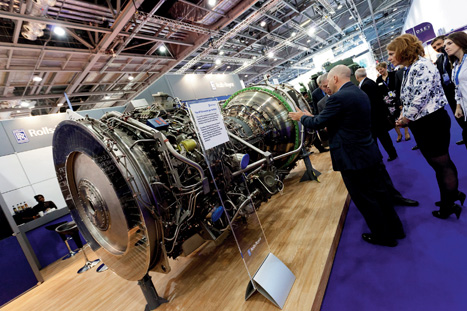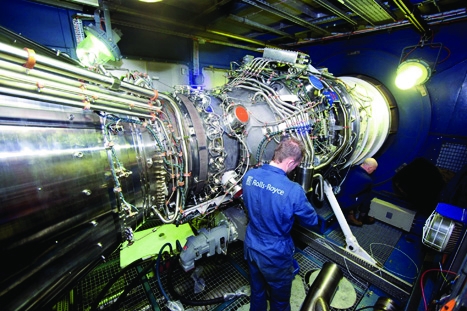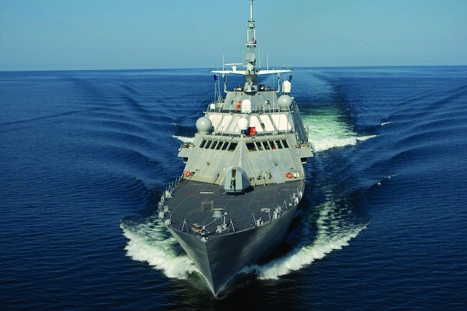The ’beast of the seas’, as Rolls-Royce describes it, greeted the world from the company’s stand at the recent London defence exhibition DSEi. The MT30 marine turbine — the most powerful marine turbine in the world — is, like many celebrities, smaller in real life. Even its product director describes it as ’dumpy’.
But the unprepossessing steel cylinder is at the heart of some of the most glamorous vessels in the world’s navies. It’s the powerhouse of the UK’s Queen Elizabeth (QE)-class aircraft carriers, which will each house two of the turbines to generate electricity for propulsion and on-board systems. And across the Atlantic it provides the power for the US’s latest destroyers, the DDG1000 class, and its littoral combat ships (LCSs). Each LCS will, like the QE carriers, carry two turbines but these each power two Rolls-Royce waterjets, propelling the 3,500-ton vessels at speeds in excess of 40 knots.

’It’s dumpy because it’s a twin-spool design, with IP [intermediate-pressure] and HP [high-pressure] compressors running off separate shafts,’ explained product director Alan Millichamp. ’It’s shorter than our competitor’s engine, which only has one compression system and a much longer shaft with more compression stages.’
The short length of the MT30 is an advantage, Millichamp explained. When a gas turbine engine shuts down, the heat generated inside soaks into the shafts. Long shafts tend to bow as they expand, which means that the engine can’t be restarted until it has cooled down, to prevent it running off balance. ’We don’t have that problem, so we can start whenever we want.’
Like most marine turbines, the MT30 is based on an aero engine — in this case Rolls-Royces’s Trent 800, which powers the Boeing 777. ’Marine volumes are much smaller than aero engine volumes, so it isn’t economic to develop a turbine just for that sector,’ Millichamp said. ’Being part of a larger aero family brings all the reliability that’s so important for, and built into, the aero engine market to the sector. We’re about 80 per cent common with the Trent 800, and in fact the core modules of the engine are built on the same production line as the Trent.’
“It’ll go from cold to full power in five minutes, which is half the time of a conventional engine”
ALAN MILLICHAMP, ROLLS-ROYCE
The main difference between the marine and aero models is the fan at the front of the aero engine, which is missing in the MT30. ’Normally, the drive from the fan comes from the LP [low-pressure] turbine at the back, with a shaft running through the engine that drives the fan,’ Millichamp said. ’We take off the fan, remove the shaft and reverse it out of the back of the engine. That provides the power to drive an alternator synchronously, to generate electricity, or run it through a gearbox to drive a propellor or waterjet.’

Running an alternator, the MT30 will generate 40MW and it’ll do it fast. ’This engine is often used as a booster, so when you want power you want it quickly. This is a quick-start engine — it’ll go from cold to full power in five minutes, which is half the time of a conventional engine.’
Basing the engine on an aero model also meant it was quick to develop, Millichamp added. ’An aero engine will have 11 or 12 engines in the development programme; we had two,’ he said. ’Basically, we instrumented as many of the components as we could to prove that they were operating in the same environment as an aero engine. Once we’d done that, all the certification data moves straight across to the marine environment. We then took the instrumentation off and put one of the engines into ABS certification where you do a 1,500-hour endurance test and achieved certification in six months, which is the fastest it’s ever been done.
There was some adaptation from other engines — the gearbox comes from a Trent 500 and the IP turbine blade is from a Trent 700, as this has better corrosion properties than the Trent 800s. The main re-engineering involved the shaft and its bearing arrangement at the rear of the engine; the rest is basically Trent 700.
Its product director describes it as ’dumpy’, but the unprepossessing steel cylinder is at the heart of the most glamorous vessels in the world’s navies
The part numbers aren’t the same, because we burn a much higher sulphur fuel in the marine environment and the components have to be protected from the very harsh environment that creates; other components have to be protected to cope with salt,’ Millichamp said. ’We take the parts off the line, apply the necessary protective coatings then put them back for assembly. But other than that, they are the same components.’

Millichamp is confident that the MT30 will hold its position as the world’s largest marine turbine for some time. ’It’s the largest core of a civil aircraft engine that’s available at the moment and there won’t be a bigger one unless something radical changes in engine design.’ It’s also fuel efficient, although this comes from its power density. The conventional way of increasing the efficiency of an aero engine, making the fan bigger to increase the bypass ratio, isn’t available in the engine with no fan. ’But it’s very good for maintenance, especially because it’s a new engine. It’s modular, which reduces the need for spares holding; you can take it out of the ship, swap over whichever module is faulty, and drop it straight back in.’
The high energy output is very attractive for naval architects, he added. ’Ships are looking at a bigger load for radar systems and other on-board systems, and in the future for propulsion; the MT30 will generate all it needs. For the carriers, the decision to go for catapults rather than STOVL aircraft also suits this turbine; the two units on board will be able to generate enough to power electrical catapults.’
the data
brute strength
The MT30 is the most powerful marine turbine in the world
Length: 4.4m
Weight (engine): 6,346kg
Weight (including enclosure and ancillary systems): 27,780kg
IP compressor: eight-stage variable geometry
HP compressor: six-stage
Output shaft speed: 3,600rev/min (alternator), 3,300rev/min (mechanical drive)
Power output: 40MW




Red Bull makes hydrogen fuel cell play with AVL
Formula 1 is an anachronistic anomaly where its only cutting edge is in engine development. The rules prohibit any real innovation and there would be...